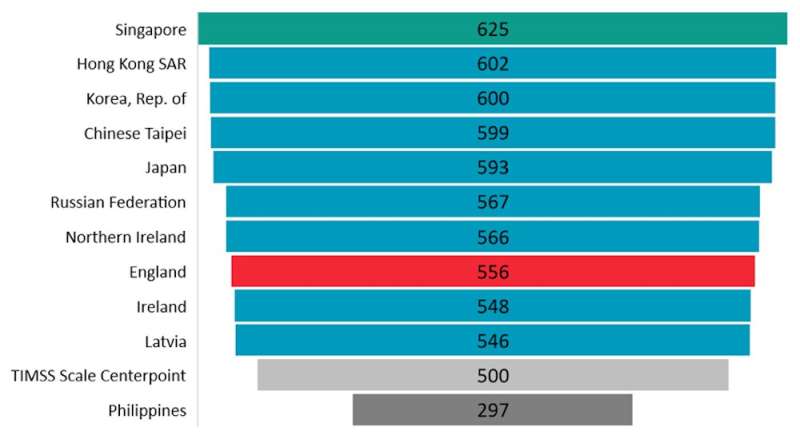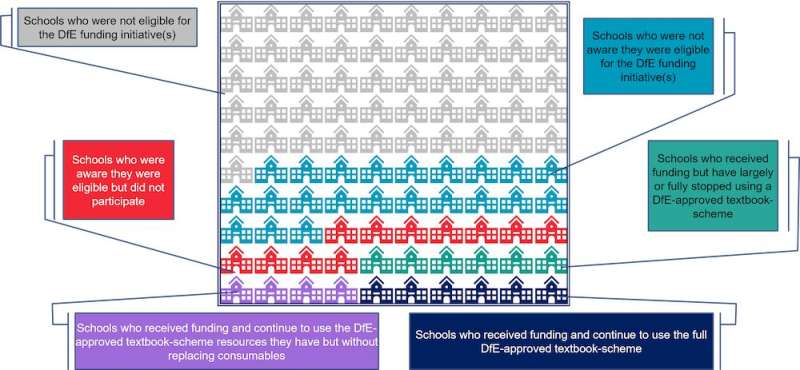This article has been reviewed according to Science X's editorial process and policies. Editors have highlighted the following attributes while ensuring the content's credibility:
fact-checked
trusted source
written by researcher(s)
proofread
England's plan to introduce east Asia-style math textbooks widely rejected by primary schools

Prime Minister Rishi Sunak recently outlined a plan to improve math skills in England, which will see young people study the subject at school until they are 18. This sounds straightforward but it's worth considering how tricky new educational policy is to get right.
Take, for example, a previous attempt by the UK government to improve children's math skills. In 2016, a multi-million pound initiative was launched offering more than 8,000 primary schools in England funding to buy math textbooks featuring teaching methods based on those used in some east Asian countries.
We don't yet know if the schools who used the textbooks saw any effect on their pupils' attainment. The results of SATs—tests taken at the end of primary school—haven't been published since 2019 due to the COVID pandemic.
However, my research with colleagues shows this initiative, which ran until the 2021-22 academic year, was not widely popular with teachers and school leaders—and that the majority of English primary schools did not take up the funding. Of those that did, more than a third have subsequently stopped using the textbooks completely.
Data suggests that on average, children in England do pretty well at math compared with other countries. The latest international study shows the performance of England's nine- to ten-year-olds has increased steadily, now ranking eighth out of 58 jurisdictions.
But challenge lies behind the averages. England has one of the largest gaps in the world between the highest and lowest performers, and a persistent gap in math attainment between pupils from disadvantaged and non-disadvantaged backgrounds.
Wanting to change these patterns for our youngest learners, the government looked to the teaching practices of the highest performers internationally—predominantly east Asian regions—to see what England could "borrow".

Several exchange projects later saw the "mastery" teaching approach pushed in English primary schools. The mastery method breaks learning down into small blocks and requires that a pupil is competent in a topic before they can move on to another.
Schools minister Nick Gibb announced extended funding in 2016 supporting this push, with a central strand being provision for around 8,000 eligible schools to purchase math textbooks through matched-funding grants of £2,000.
Schools could choose from two government-approved textbook schemes: Math—No Problem! and Power Math. Each scheme included physical textbooks, workbooks for pupils to write in (which must be renewed each year), and subscription-accessed online material including lessons and teacher guides.
To assess the popularity and effectiveness of this approach, we distributed a nationwide survey to all 17,038 state primary schools in England in 2021-22. We received 664 responses, a representative sample. We wanted to find out more about the resources teachers were using to teach math and how far this included the government-approved mastery textbooks.
We were taken aback to discover that more than 100 different math resources are in use in primary schools across England. These vary from complete schemes to topic-focused resources, from online to physical and from free to pay-per-view.
We also found that teachers spend considerable time sourcing and adapting material, with more than a third of primary teachers spending their own money purchasing resources. This clearly clashes with the government aspiration that schools should move to teaching predominantly through textbooks.
A mismatched approach

Our survey found that two-thirds of the schools eligible for textbook funding under the scheme launched in 2016 did not take it up. While some were unaware they were eligible, others made a resolved choice not to participate.
Participants from these schools told us of an ideological dislike of textbook-based teaching. A quarter of schools felt they couldn't meet the matched-funding element, or the ongoing costs. This shouldn't come as a surprise, given that costs to schools are growing more quickly than previously experienced.
Of greater concern—especially looked at from a value-for-money perspective—was that 37% of primary schools that took up the funding have since completely stopped using the textbooks. A further 24% are only using the purchased textbook schemes in a partial way—for example, still using the physical textbooks but not purchasing pupil workbooks or renewing their online subscriptions to support materials.
In all, only just over 10% of primary schools that were eligible for the textbook scheme took it up and are still using it in full.
Summary of our survey results:
The government's shift to learning from the east Asian education system was a complete about-turn. It meant importing practices that sat at odds with primary school approaches in England, where teachers look after all needs of their class, rather than being subject specialists.
Textbooks, particularly in primary math, have not been popular in primary schools for some time. As well as being costly, they can be seen as a threat to professional identity by taking away teacher control.
Our research underlines that we need a solid understanding of how math teaching is done in England before adding in any new initiatives or policy—not only what's happening in classrooms, but the complex reasons behind why it is happening. We hope governments learn from the inefficient administration reported here before implementing further new or borrowed policies.
Provided by The Conversation
This article is republished from The Conversation under a Creative Commons license. Read the original article.![]()



















